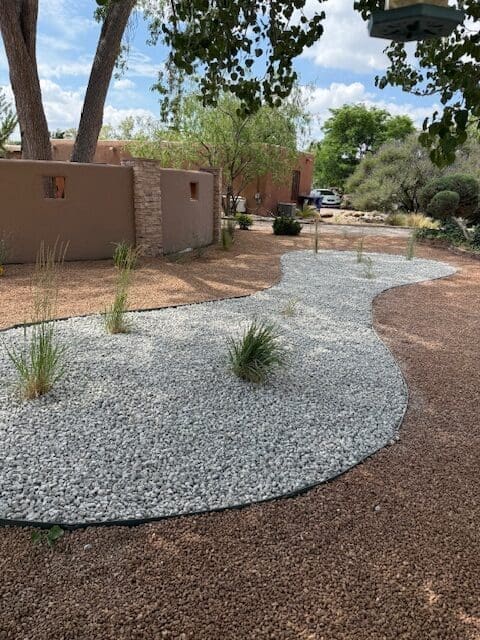How Do I Use Xeriscaping to Save Water and Money on Landscaping?

Xeriscape landscaping or “xeriscaping” as it is known, by definition is landscaping planned specifically for areas that are prone to drought, for properties where water conservation is practiced.
That comes from the Greek xeros, meaning “dry,” and refers generally to a “dry landscape” (after all, gardens included) in dry climate regions. In short, xeriscape landscaping is a form of garden that can thrive on very little water.
While it was developed in water-poor, hot-and-dry environments, xeriscaping is now applicable to many different climates that want to conserve their valuable water. Furthermore, xeriscaping practices are usually designed the same way as they would in any other form of landscape design.
Here are essential tips and advice for getting started with xeriscape landscaping and saving money:
Why Is Xeriscaping Important?
When you arrange the plants according to their water requirements, and use mulch, and some drought-resistant plants, you will conserve lots of water.
You will be growing healthier gardens and landscapes, and also require less use of fertilizers and pesticides. And remember, whatever you do in your yard and garden sooner or later affects your water supply and ultimately local bodies of water.
We hear plenty about pollution caused by industry and factories. These are considered “point sources.” Homeowners and people are “nonpoint” sources of pollution. That fertilizer and bug spray that you use on your plants may not seem like much, but the accumulated runoff from all those “nonpoint sources” is substantial indeed.
Xeriscape Benefits
Besides conserving water, xeriscape designs does have one primary attribute; reducing what is devoted to lawn grass, as the latter can be a very serious offender toward water conservation.
The advantages of replacing a lawn with a low-maintenance xeriscape garden include:
- Cutting back on automatic yard sprinkler service and system costs
- Discontinue chemical usage and lawn pest management methods for maintaining a lush lawn
- Less fear of sprouting a brown lawn
- Using much less labor and time to take full care of your lawn when you xeriscape
How to Practice Xeriscape Landscaping
The underlying concepts of xeriscaping are pragmatic and easy to apply when trying to conserve water. Forget about the details, all you need to know are what are the important techniques, and concepts which lay at the principles of a good garden.
Planning and Design
Creating a water-wise garden requires planning. Rather than thinking aesthetic first, consider your garden’s topography, exposure and soil. Don’t try to fight your site. Form planting zones and rely on groupings of plants to serve their needs.
For another, you would naturally group tough plants that can handle drought in areas with full-day sun, perhaps give more delicate plants a little partial shade and save those fussy or tender kinds for closest to your water source.
Choosing Appropriate Plants
There’s no reason that xeriscaping has to mean cacti and succulents. There are a lot of good looking plants with low water requirements capable of thriving in xeriscapes.
Use indigenous plants in a xeriscape garden with the collection of natural rain water and no artificial watering other than when you first plant them. There will be regional variations, perhaps even from one side of a town or street to the next, in what sort of planting might work best.
Reducing or Eliminating Turf Grass
Xeriscape design does not typically contain turf grass in place of plantings and ornamental grasses. Lawn areas are usually converted to flower beds, hardscapes, or rock gardens. Because it requires lots of water, fertilizer and fuel to keep your lawn green.
Designing it without lawn grass as a major element may be wise. For those who want to maintain some lawn, select an appropriate grass-seed mix for the lawn’s exposure. Imagine alternatives to lawn, like drought-tolerant groundcovers that take less work and water.
Organizing Plants with Similar Needs
Pair plants with the same watering needs next to each other. And separating water “thirsty” plants from those that need far less can save you money, while reducing the odds of overwatering the less needy specimens.
Drip irrigation systems enable you to control when and how much a plant is watered, and direct the flow only to the areas of the garden that require it. Water when your plants need it, not by the calendar. All plants will need additional water until they are established—usually for the first year or two. But once they have established, you will probably not need to water as much.
Improving the Soil
Well-draining soil is important when it comes to successful xeriscape landscaping. Bad dry soil is short on organic matter, so it cannot absorb water or drain it well. Drought-tolerant plants don’t like wet feet. Those conditions can be tough on drought-tolerant plants, but some xeriscape-friendly plants may even prefer the poor, dry and rocky soil.
It’s ideal to prepare the soil before planting by working in plenty of compost and organic matter that will loosen the soil to allow water to get in and retained well enough so that it drains. Rich, porous, water-holding soil will help the roots get a good start and reduce the plant’s demand for extra water.
Mulching to Hold Moisture
Mulch A water-wise garden would be incomplete without mulch. It moderates the temperature of soil, traps moisture, slows erosion and suppresses weeds that rob your plants of food and water. It also slowly breaks down, nourishing the soil. He recommends a 4-inch layer of mulch at the time of planting, and to inspect annually for any gaps.
Maintaining Appropriately
Good watering, weeding, pruning and deadheading can’t be overlooked nor should thoughtful pest management.
